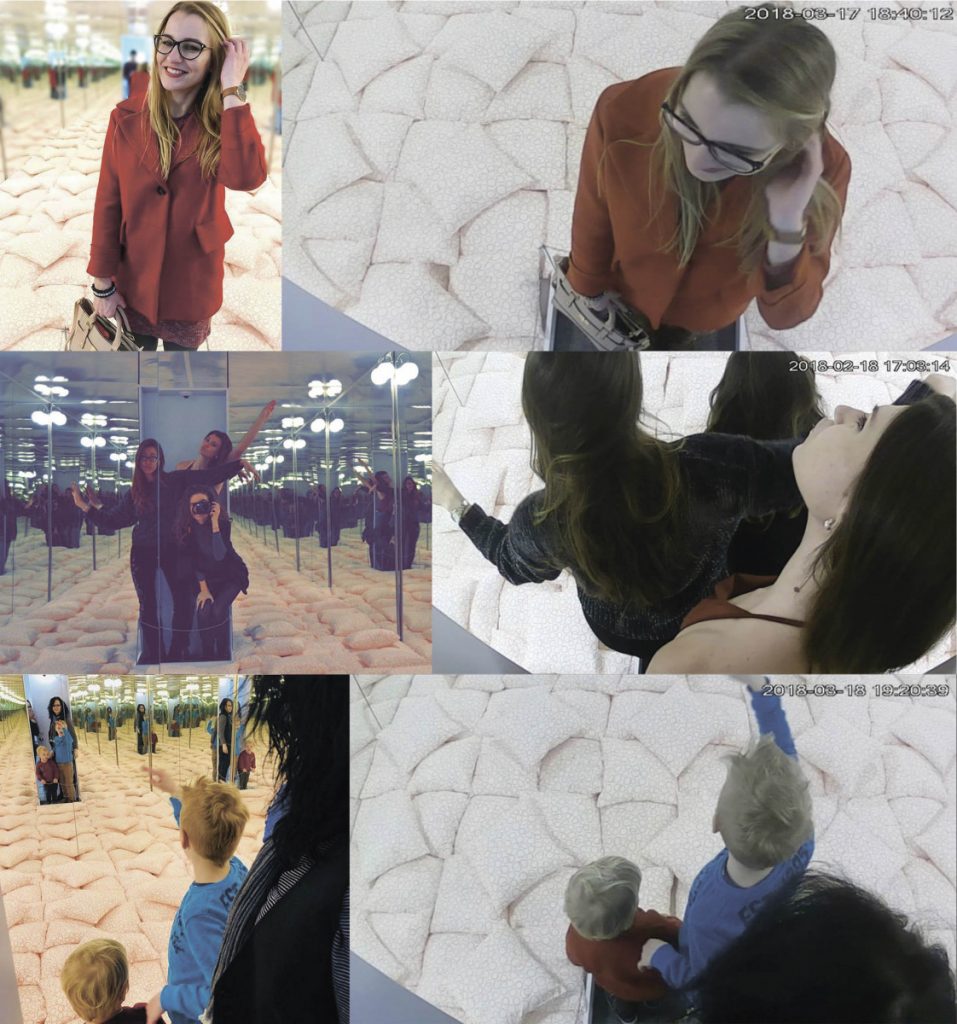by Helena Nikonole
“Art as radar acts as
‘an early alarm system,’
as it were, enabling us to
discover social and psychic targets
in lots of time to prepare to cope with them”
Marshall McLuhan, Understanding Media, 19641McLuhan, M. (1964/2003). Understanding media: The extensions of man. Corte Madera, CA: Gingko Press. (p.21)

Over the last 6 years we have been witnessing a rapid development of a technology called Artificial Intelligence (AI), which is essentially Machine Learning or Deep Learning based on the concept of artificial neural networks, mathematical models inspired by biological neural networks. This technology demonstrates human-competitive performance in certain tasks such as classification, clusterization, object recognition, prediction, and optimization.
Mass culture offers a popular image of singularity, wherein strong artificial intelligence, humanity’s antagonist, is trying to overcome and go beyond the imperfect and obsolete human brain. However, today’s weak AI, which is largely controlled by states and corporations is, in fact, a significantly more dystopian phenomenon than the one presented in mass culture.
This year we are seeing AI technology merge with the Internet of Things (IoT): from “Nest’s” smart thermostats to wearable healthcare devices. In July 2018, Chinese company Dahua launched a smart-camera and server for surveillance systems integrating AI face-recognition capable of detecting gender, age, and emotions2Dahua unveils deepsense face recognition network cameras. (2018, July 17). In Asmag.com – Security & IoT. Retrieved from: https://www.asmag.com/showpost/25678.aspx. At the same time, the Russian NTechLab, which has one the best face-recognition technologies in the world, has declared that it is closing its service FindFace (which was basically a face-search engine on the Russian social network VK) for private use, and is now going to provide this technology only for states and enterprises3findfaceblog.(2018,July 3). FindFace закрылся (FindFace closed). Retrived from: https://findfaceblog.wordpress.com.
Trevor Paglen, an artist largely working with AI over the last 2 years, emphasized in his talk at the Art\Politics conference in Berlin last May that every image uploaded to the internet is first seen by a machine’s eyes before human ones4Paglen, T. (2018, May 12). Invisible Images. Art / Politics Conference at Neuer Berliner Kunstverein (n.b.k.).. We can say the same about many devices within the Internet of Things: many streams from IP-cameras are processed by machine vision: registered, analyzed, recognized, or even judged. And very soon, all content and information from the physical world captured by the ubiquitous IoT devices will be perceived by AI cloud processing.
AI based on artificial neural networks is not a brand new concept: it has a history of about 70 years. However, it was only 6-7 years ago that it started becoming such a powerful tool: first, because of increased computing power and second, because of massive datasets collected from the internet, which both made machine learning possible. Datasets are still being collected to train AI every moment we go online, but today this is happening even when we think that we are off the grid. “Surveillance is the business model of the internet,” Bruce Schneier writes in his essay5 Schneier, B. (2016, January 13). The Internet of Things that Talk About You Behind Your Back. Schneier on Security blog. Retrieved from: https://www.schneier.com/blog/archives/2016/01/the_internet_of.html. According to research, (conducted at Princeton University, or Associated Press investigations) Google is tracking our movements even if we switch off GPS tracking and remove the SIM-card, and we cannot opt out6Nakashima, R. (2018, August 13). AP Exclusive: Google tracks your movements, like it or not. AP News. Retrieved from: https://www.apnews.com/828aefab64d4411bac257a07c1af0ecb. So it comes as no surprise when Google acquires Nest Labs, the producer of self-learning smart heaters and security cameras, since tech giants have a tendency to collect as much data as possible.
IoT is not a step towards smart cozy houses and cities, but rather a means to gather data of our presence and actions in the physical world. “The Internet of Things … simply wants those new forms of digitised command and control”7Sterling, B. (2014). The Epic Struggle of the Internet of Things. Moscow, Russia: Strelka Press. (p.21). Therefore, IoT and AI together become a potential new tool for algorithmic regulation.
deus X mchn (2017)
In the project deus X mchn I explore the controversial concept of algorithmic regulation which can be now further developed based on the integration of AI and IoT. In this project, an AI (an LSTM-neural network possessing a long-short-term memory), has been taught the language contained within a corpus of sacred texts such as The Old and The New Testament, the Quran, the Torah, the Dhammapada, the Ramayana, the Tao Te Ching, and others. It perceives the text as a sequence of numbers (encoded symbols). The AI performs Big Data computations based on the texts in order to discover their grammatical structures, i.e. the “code” of the language. Eventually, this neural network starts to generate its own “sacred” text, creating new words and revealing the universal poetics of religious writings.

Another neural network uses this text for speech synthesis and artificial intelligence becomes the voice of unsecured devices on the Internet of Things: IP-cameras with speakers start reciting this (pseudo-religious) text to unsuspecting users; audio files containing the text are left on people’s media-servers for them to be discovered. Finally, these texts are simultaneously printed once every 30 minutes both on an IP-printer in the exhibition space and on a randomly chosen device somewhere in the world.
Within the framework of the project, a series of photographs automatically taken by a scanning script, which takes random screenshots from IP-cameras, were also presented.
The project introduces the IoT not only as Michel Foucault’s Panopticon8Foucault, M. (1975/1999). Discipline and Punish: The Birth of the Prison. Moscow, Russia: Ad Marginem. , but rather as a tool of biopolitics9Foucault, M. (2010). The Birth of Biopolitics. Moscow, Russia: Nauka. , a system of surveillance and control and a way of nudging citizens towards preferable behavior, instead of trying to understand and deal with the root causes of social problems. Evgeny Morozov considers this concept of data-based governance an extension of technological “solutionism,” which is his term for a tendency to recast “all complex social situations either as neatly defined problems with definite, computable solutions or as transparent and self-evident processes that can be easily optimized—if only the right algorithms are in place.”10Morozov, E. (2013). Chapter One, Solutionism and its Discontents In E. Morozov, To Save Everything Click Here (pp. 1-16). New York, NY: PublicAffairs.11Morozov, E. (2018, January 28). Will tech giants move on from the internet, now we’ve all been harvested? The Guardian. Retrieved from: https://www.theguardian.com, He points out that this approach can eventually cause more damage than the problems it seeks to address.
The Other View (2018)
For this project I connected to IP-cameras at a mirror gallery imitating Yayoi Kusama’s mirror installations. The visitors are taking “selfies” in these mirrors and posting them on social media. This project demonstrates the supplementation of IP-camera surveillance by self-representation through social media.
An IP-camera at the mirror gallery is installed to look down from above the entrance and shows a non-human point of view by observing reality as it is. At the same time, visitors represent clichés of social constructs by looking at themselves from an “imaginary Other’s” point of view.

In this work, I’m exploring two perspectives of surveillance: first, the gathering of our data by tech companies through social-media based on the information we provide in exchange for their free services and, second, the surveillance of our physical presence by IoT devices, in this case IP-cameras.
“Social media that are based on targeted advertising sell prosumers as a commodity to advertising clients. There is an exchange of money for the access to user data that allows economic user surveillance.”12Fuchs, C. (2014). Social Media / a Critical Introduction. Ltd; New York, NY: SAGE Publications. (p.108)
Big Data AI-processing based on our previous activity is now determining many of the kinds of information we receive online, such as search engine output and social media news feeds, anticipating what we would like to see. Smart devices, by collecting further information of our activity in the material world, will share this information with states and corporations to control and define our reality. But the disturbing thing about AI is that we never know why it provides certain results based on our own data. Even their creators and scientists are not able to explain that.
AI is a kind of a black-box, the inner workings of which are incomprehensible. It can make dangerous mistakes and it can emphasize society’s typical biases, as was illustrated in the controversial cases when Google Translate and Apple autocomplete demonstrated sexism, and it is capable of other forms of discrimination as well13Zou, J., Schiebinger, L. (2018, July 18). AI can be sexist and racist — it’s time to make it fair. Nature – International journal of science. Retrieved from: https://www.nature.com/articles/d41586-018-05707-8.
It becomes harder to believe that technology can make the world more equal or more free, when we are well aware that AI can be used to manipulate public opinion, when we know that AI and IoT surveillance systems are deployed by enterprises for labor surveillance and suppression and by states to control citizens, or when we know that people are preparing datasets to train machine learning algorithms at Amazon Mechanical Turk and get paid $1 per hour, or at a similar Russian service Yandex Toloka for a meager $0,4 per hour14The Yandex ad says people can earn 1-1.5$ per hour. In many reviews on internet people write it’s about 0.4 – 0.6. Some of them earned even less. Yandex stories: http://zarablegko.ru/moy-opyit-zarabotka/yandeks-toloka-otzyivyi/, https://ifyes.ru/work/eksperiment-skolko-mozhno-zarabotat-na-yandeks-toloka.html.
However, the same technologies can not only be used by companies and states but can also be hacked and exploited by open source communities, activists, makers, and artists who can anticipate both technology’s potential opportunities and the potential risks and dangers which techno-evangelists have not yet realized.
We can use IoT and AI as tactical media to spread information which states and companies are trying to hide; we can launch blockchain databases which collect cases of censorship or human rights violations deployed on IoT; we can perform distributed computations based on IoT CPUs in search of treatments for cancer; we can build open source software to control IoT and DIY IoT solutions based on cheap microcontrollers; we can demand transparency for companies and states and privacy for people. Finally, we can experiment with AI to understand the way it works in order to become aware of its biases and perhaps, some day, we can find a way out of this dystopian present.
Helena Nikonole is a media artist and lecturer based in Moscow, Russia. Her work explores intersections of art and technologies such as Artificial Intelligence and Internet of things. She presents lectures and workshops in the field of new media art and new aesthetic at different institutions including National Center of Contemporary Art (Moscow), Institute of Philosophy (Russian Academy of Sciences), Office of educational programs in the field of arts and culture at the Department of Culture of Moscow, Rodchenko Art School, etc. Exhibitions include Open Codes ZKM Center for Art and Media in Germany, The Wrong – New Digital Art Biennial, «IAM» GARAGE Museum Moscow, New Codes of Art, ELECTROMUSEUM (VI Moscow Biennial of Contemporary Art), PolitechScienceArt exhibition at GARAGE Museum Moscow, Earth Lab (The Polytechnic Museum and Ars Electronica Center collaborative project), 101 Mediapoetry Festival (St. Petersburg) and many others.